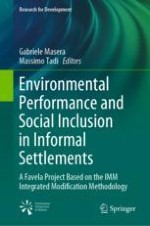2020 | OriginalPaper | Chapter
Solar Technologies as a Driver to Limit Energy Poverty in the Rocinha Favela
Authors : Francesco Causone, Anita Tatti
Published in: Environmental Performance and Social Inclusion in Informal Settlements
Publisher: Springer International Publishing
Activate our intelligent search to find suitable subject content or patents.
Select sections of text to find matching patents with Artificial Intelligence. powered by
Select sections of text to find additional relevant content using AI-assisted search. powered by
